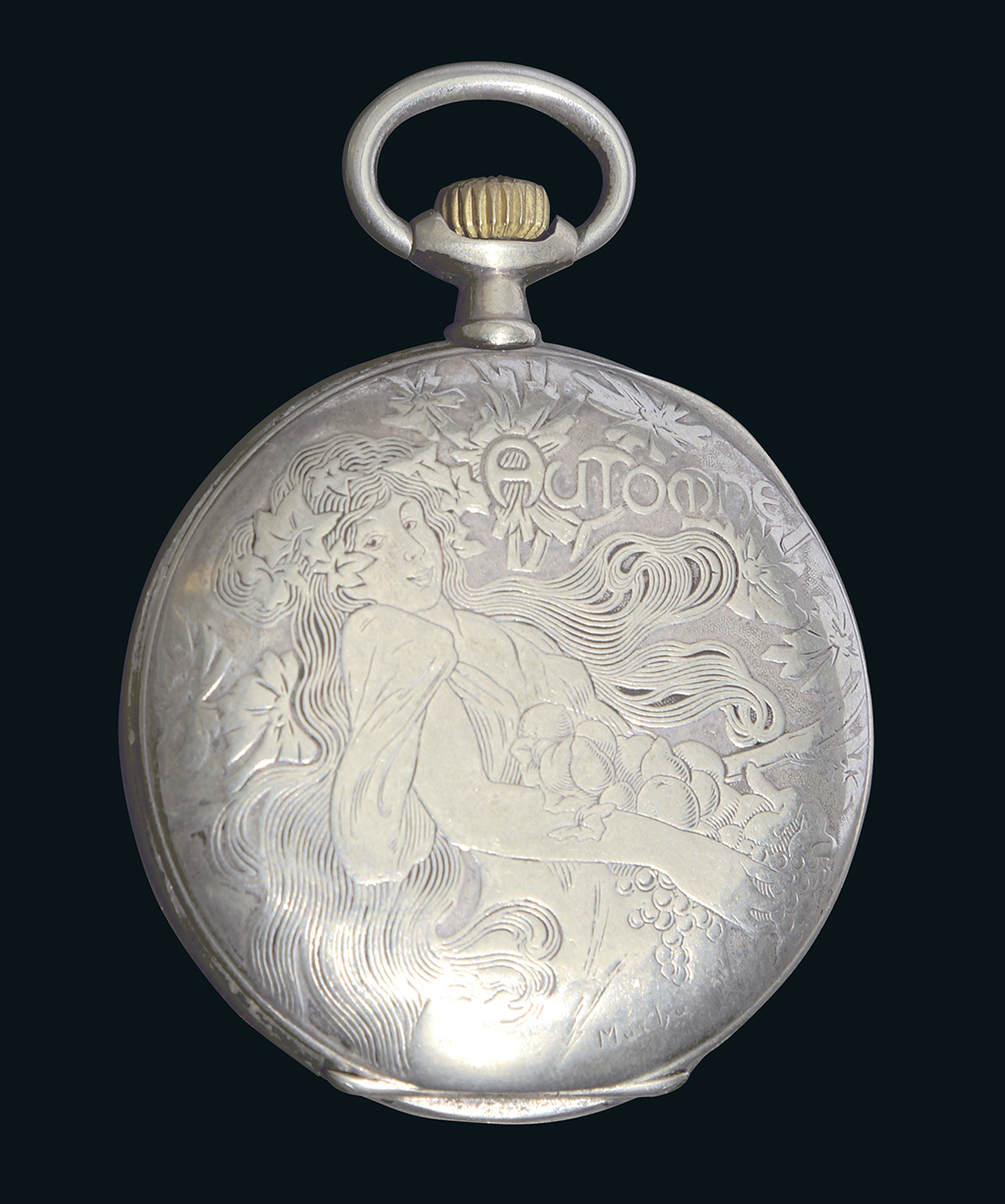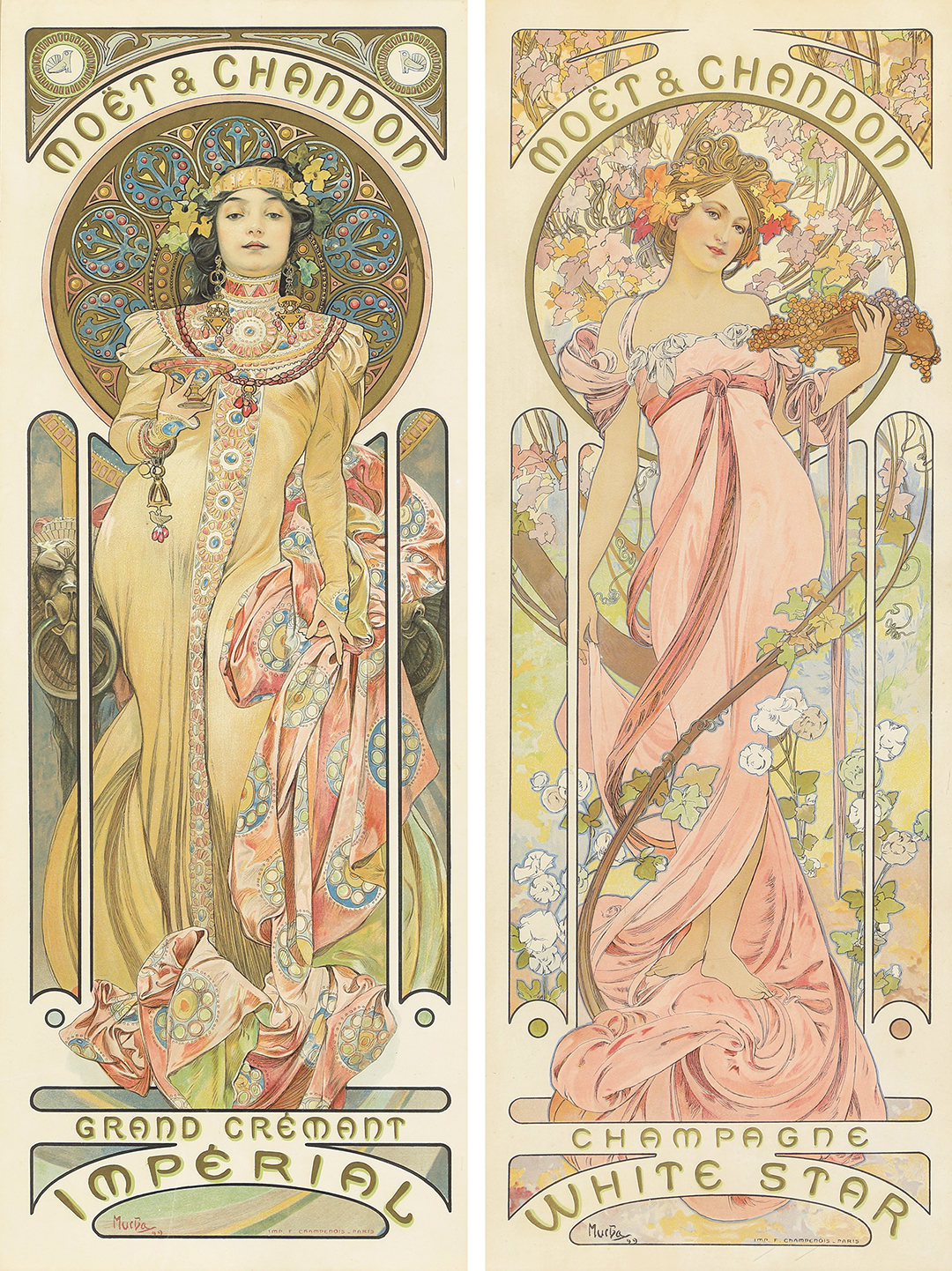While a choirboy at the Cathedral of St. Peter & Paul in Brno, the capital of Moravia, Alphonse Mucha had a divine revelation about the nature of the Baroque aesthetic. It took him to Vienna, Munich, and finally to Paris, where the 1900 Universal Exhibition brought him international renown. The spiritual and the commercial appear perfectly wedded in his work, but he was conflicted about this his entire life.
Est: $20,000-$25,000
For many years, this design was simply known as “Reverie,” the name under which the decorative panel version of the design was widely sold by La Plume without lettering. However, further research appears to establish that its original use was as an in-house poster for a variety of establishments, from printing firms to chocolate manufacturers. Here, however, is the first incarnation of the design, used by F. Champenois to usher in the New Year of 1898. This is one of the finest specimens ever seen.
Est: $17,000-$20,000
Zodiac “turned out to be one of [Mucha’s] most successful designs… The editor of La Plume liked it so much that he bought it for his magazine almost immediately and started giving it wide publicity… Mucha’s customary circular background here serves the functional role of carrying the symbols of the zodiac. The ornamental shapes and patterns around the perimeter are worked out with a precision and attention to detail unusual even for a meticulous artist like Mucha” (Rennert/Weill, p. 100). In this version, we have the magazine’s name, address, and subscription rates at top and the 1897 calendarium at bottom.
Est: $40,000-$50,000
Although we don’t often see jewelry at our poster auctions, this piece is a wonderful exception. Mucha himself was a fan of designing wearable accessories. So when Georges Favre-Jacot, the founder of Zenith watches, asked Mucha to contribute a design, the answer was a resounding yes. Mucha adapted his 1896 Seasons imagery for the four designs; this one presents his Autumn panel, which was engraved in niello silver by Huguenin Frères. The details of the watch are as follows: round silver case, oval bail, fluted crown, officer back, white enamel dial, Arabic and Roman numerals painted black, “English Pear” hands in blued steel, and signed dial and movement. The watches were so distinguished that they were awarded the Grand Prix (or Grand Prize) at the 1900 Paris World’s Fair. There are six known sets of watches, four of which are in the Zenith Foundation Museum, one given to the city of Paris, and the single image offered here. Rare!
Est: $12,000-$15,000
“One of Mucha’s most endearing and enduring sets… Spring is a blonde sylph who seems to be fashioning a makeshift lyre out of a bent green branch and her own hair, with some birds as interested spectators. Summer… sits dreamily on the bank of a pond, cooling her feet in the water and resting her head against a bush. Autumn is an auburn lady, making ready to partake of [a] ripe grape. Winter, her brown hair barely visible as she huddles in a long green cloak, snuggles by the snow-covered tree trying to warm a shivering bird with her breath… All four panels were printed in [this] smaller format and placed in an ornamental frame, with the names of the seasons on a decorated background underneath. Each panel is surmounted by a cameo-like ornamental motif” (Rennert/Weill, p. 90 & 96). This is the smaller format.
Est: $25,000-$30,000
“For the firm of Moët & Chandon… Mucha executed a number of designs which were used on menus, postcards and other publicity. Two of his assignments were for posters; one of them was used to advertise their White Champagne… while the other served to publicize the… Crémant Impérial. [White Star’s] seductive being tempts us with choice grapes in a lovely outdoor setting, with flowers at her feet and vine tendrils and leaves all about her head… [While Crémant Impérial is a] grand design for a grand wine—the serene repose of the classically beautiful face, the gentle flowing garment, the delicate hues, the rich ornamental pattern, and the precise handling of spaces and shapes” (Rennert/Weill, p. 244). (2)
Est: $25,000-$30,000
Created for special clients to show off the company’s printing skills, this is the rare and incredibly lustrous version of Mucha’s earlier Job on silk—made all the more special with the master’s own signature.
Est: $20,000-$25,000
This poster is coded with the stories of roads not taken. In 1927, a Czech opera singer living in New York, Otakar Marák, had an epiphany: he would jump-start the sound-movie industry in Czechoslovakia. He seized upon the idea to work with Lee de Forest (1873-1961), a radio pioneer who had invented sound-on-film recording—i.e. a “sound track”—whereas everyone at the time was trying to sync silent film with phonograph records. (De Forest had first demonstrated the idea with an opera singer performing an aria from “Rigoletto.”) Marák got Mucha, a friend, to create the poster—an allegory of a performing artist urged on by a Muse, with the spool of a film reel signifying de Forest’s film technology. Tragically, just months after Marák conceived the idea, Al Jolson’s “The Jazz Singer” was released, using the old, inferior phonograph technology. But the all-singing, all-dancing spectacle captured the imagination of the crowds; a stationary opera singer on de Forest’s demo simply couldn’t compete. Much later, the large Hollywood studios finally appropriated de Forest’s soundtrack technology—without paying him. De Forest was eventually vindicated in the drawn-out lawsuits that followed, but it was too late to claim the profits owed him. De Forest would claim, proudly, that he made and lost four fortunes.
Est: $25,000-$30,000
Mucha’s daughter is the subject of this quite intimate and contemplative drawing, which likely served as the preparatory work for his oil portrait of her (which is part of the Mucha Trust collection). Jaroslava often posed for her father and also worked as his technical assistant. Here, she makes intense eye contact with the portraitist, but retains an element of mystery with her chin resting gently on her fingertips.
In-gallery viewing June 29 – July 17 (11am-6pm daily)








